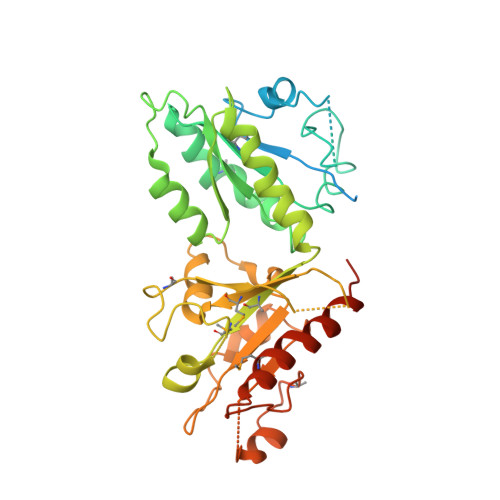Crystal Structure Analysis of Wild Type and Fast Hydrolyzing Mutant of EhRabX3, a Tandem Ras Superfamily GTPase from Entamoeba histolytica.
Srivastava, V.K., Chandra, M., Saito-Nakano, Y., Nozaki, T., Datta, S.(2016) J Mol Biology 428: 41-51
- PubMed: 26555751
- DOI: https://doi.org/10.1016/j.jmb.2015.11.003
- Primary Citation of Related Structures:
5C1S, 5C1T - PubMed Abstract:
The enteric protozoan parasite, Entamoeba histolytica, is the causative agent of amoebic dysentery, liver abscess and colitis in human. Vesicular trafficking plays a key role in the survival and virulence of the protozoan and is regulated by various Rab GTPases. EhRabX3 is a catalytically inefficient amoebic Rab protein, which is unique among the eukaryotic Ras superfamily by virtue of its tandem domain organization. Here, we report the crystal structures of GDP-bound fast hydrolyzing mutant (V71A/K73Q) and GTP-bound wild type EhRabX3 at 3.1 and 2.8Å resolutions, respectively. Though both G-domains possess "phosphate binding loop containing nucleoside triphosphate hydrolases fold", only the N-terminal domain binds to guanine nucleotide. The relative orientation of the N-terminal domain and C-terminal domain is stabilized by numerous inter-domain interactions. Compared to other Ras superfamily members, both the GTPase domains displayed large deviation in switch II perhaps due to non-conservative substitutions in this region. As a result, entire switch II is restructured and moved away from the nucleotide binding pocket, providing a rationale for the diminished GTPase activity of EhRabX3. The N-terminal GTPase domain possesses unusually large number of cysteine residues. X-ray crystal structure of the fast hydrolyzing mutant of EhRabX3 revealed that C39 and C163 formed an intra-molecular disulfide bond. Subsequent mutational and biochemical studies suggest that C39 and C163 are critical for maintaining the structural integrity and function of EhRabX3. Structure-guided functional investigation of cysteine mutants could provide the physiological implications of the disulfide bond and could allow us to design potential inhibitors for the better treatment of intestinal amebiasis.
- Department of Biological Sciences, Indian Institute of Science Education and Research Bhopal 462023, India.
Organizational Affiliation:


















